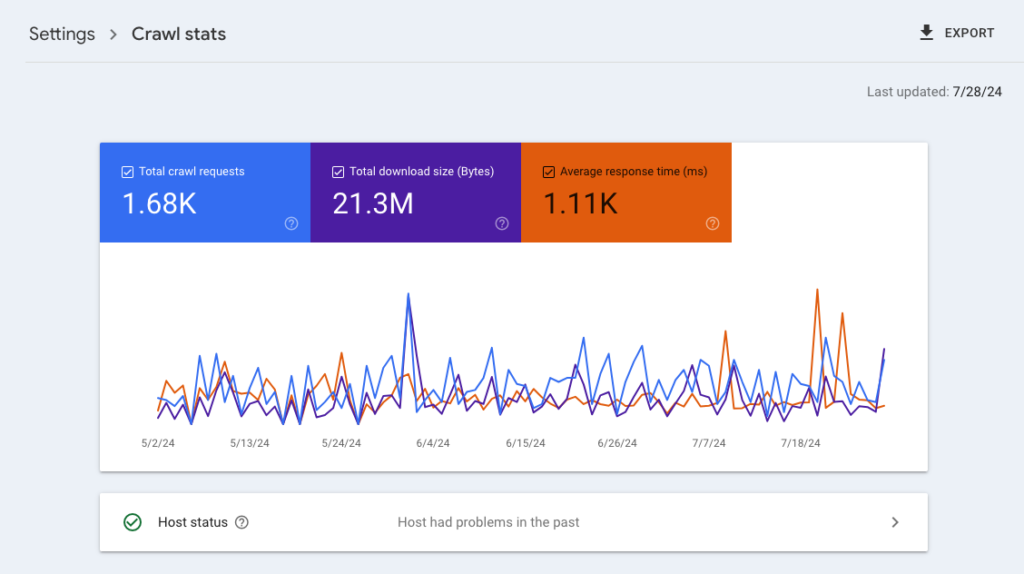What Are Crawl Stats?
Wondering, What Are Crawl Stats? Crawl stats are metrics that provide insights into how search engines, like Google, are crawling your website. These metrics are essential for understanding how often search engine bots visit your site, how many pages they crawl, and any issues they encounter during the crawling process.
Google Search Console offers a Crawl Stats report that gives detailed information about Googlebot’s activity on your site.
Key Metrics in Crawl Stats

- Total Crawl Requests: The total number of requests Googlebot made to your site over a specific period. This shows how actively Google is crawling your site.
- Total Downloaded Size: The total amount of data Googlebot downloaded from your site. This includes HTML, CSS, JavaScript, images, and other files.
- Average Response Time: The average time it takes for your server to respond to a crawl request. Faster response times are better as they allow Googlebot to crawl more pages within the same timeframe.
- Crawl Errors: Any errors Googlebot encounters while crawling your site. These can include server errors (5xx), not found errors (404), and other issues that might prevent Google from accessing your content.
Importance of Crawl Stats
Understanding crawl stats is crucial for several reasons:
- Identify Crawling Issues: Crawl stats help you identify and fix crawling issues that could prevent search engines from accessing and indexing your pages.
- Optimize Crawl Budget: By understanding how Googlebot interacts with your site, you can make informed decisions to optimize your crawl budget, ensuring that your most important pages are crawled and indexed.
- Improve Site Performance: Monitoring metrics like average response time can help you identify performance issues with your server or website, allowing you to make improvements that benefit both users and search engines.
How to Access Crawl Stats in Google Search Console
- Log in to Google Search Console: Go to Google Search Console and log in with your Google account.
- Select Your Property: Choose the website property you want to analyze.
- Navigate to Crawl Stats: In the left-hand menu, go to “Settings” and then click on “Crawl Stats.” Here you will find detailed information about Googlebot’s activity on your site.
Analyzing Crawl Stats
- Total Crawl Requests: Look at the total number of crawl requests over time. A sudden drop might indicate a problem, while a steady or increasing number usually suggests healthy crawling activity.
- Total Downloaded Size: Ensure that the total downloaded size is reasonable. Excessively large pages might slow down crawling and affect your crawl budget.
- Average Response Time: Check for any spikes in response time. Consistently high response times might indicate server issues or slow-loading pages that need optimization.
- Crawl Errors: Regularly review and fix crawl errors. Prioritize fixing server errors and “Not Found” (404) errors, as these can significantly impact your site’s crawling and indexing.
Tips for Optimizing Crawl Stats
- Improve Site Speed: Faster sites are crawled more efficiently. Use tools like Google PageSpeed Insights to identify and fix performance issues.
- Fix Crawl Errors Promptly: Regularly check for and resolve crawl errors to ensure that Googlebot can access all your important pages.
- Optimize Internal Links: Ensure that your site has a good internal linking structure to help Googlebot discover and navigate your content.
- Submit an XML Sitemap: Keep your XML sitemap updated and submit it to Google Search Console to help Googlebot find and prioritize your content.
- Use Robots.txt Wisely: Configure your robots.txt file to block Googlebot from crawling low-value pages, such as admin sections or duplicate content.
Use this code in robots.txt
User-agent: *
Disallow: /admin/
- Regularly Update Content: Frequently updated content is more likely to be crawled and indexed. Ensure that your important pages are kept fresh and relevant.
Conclusion
Crawl stats are a vital part of understanding and optimizing how search engines interact with your website. By regularly monitoring and analyzing these metrics, you can identify and resolve crawling issues, optimize your crawl budget, and ensure that your site performs well for both users and search engines.
Use Google Search Console’s Crawl Stats report to gain valuable insights and make informed decisions to enhance your site’s SEO performance.